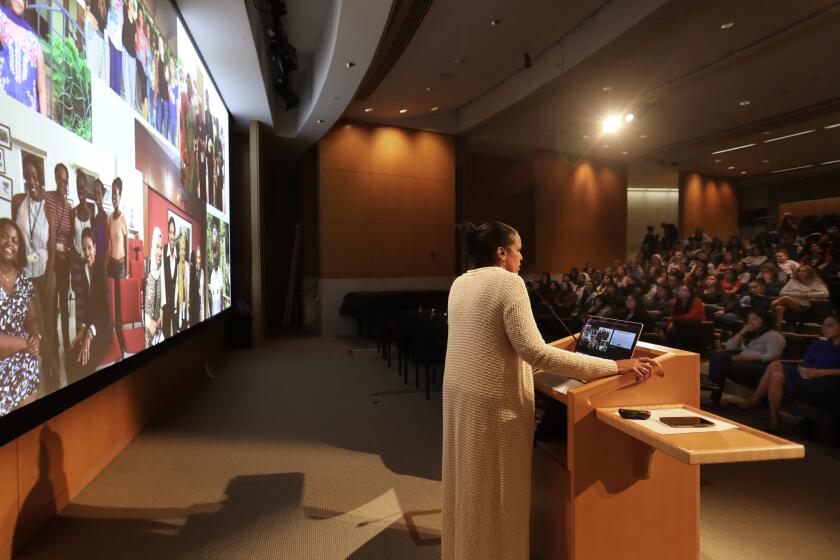Are we closing in on HIV?
With the help of vaccines, infectious diseases that have haunted humanity for thousands of years have been turned into historical curiosities.
Smallpox, which killed from 300 million to 500 million people in the 20th century, is extinct. Polio is nearly gone, having been put on the path to extinction with the first effective polio vaccine, developed by a team led by the late Dr. Jonas Salk.
And HIV might join the list, if a series of upcoming clinical trials fulfills their promise. HIV so far has bested every vaccine thrown at it, but using the hard-won knowledge over three decades of research, scientists have been eliminating false leads and homing in on the weaknesses of the AIDS-causing virus.
Testing is scheduled to begin late next year on a vaccine based in part on a new study from scientists at The Scripps Research Institute, the La Jolla Institute for Allergy & Immunology; and the International AIDS Vaccine Initiative, which collaborates closely with Scripps Research.
RELATED: HIV vaccine trial set for next year
Together with funding from the National Institutes of Health, the centers have amassed formidable expertise in understanding the structure of HIV, how it evades the immune system, and devised counterstrategies.
Another clinical trial based on a different approach has just been announced in South Africa. It’s an updated version of a trial conducted in Thailand that in 2009 reported a 31 percent reduction in HIV infection among those vaccinated.
Will these and other trials finally conquer HIV? For now, the answer depends on your outlook, Carl Dieffenbach, director of the AIDS division at the National Institute of Allergy and Infectious Diseases at the National Institutes of Health.
“Are you an optimist or a pessimist? That’s what it comes down to,” Dieffenbach said.
Reasons for optimism: Scientists have proven that HIV isn’t invincible, as shown by the existence of infected people whose immune system naturally keeps the virus in check by killing infected cells.
In addition, recent discoveries, including from the new study, show that it is feasible for nearly every human to produce antibodies that neutralize a broad range of HIV. And for those already infected, thanks to drugs available in the United States and other developed countries, AIDS has long since stopped being a death sentence.
Meanwhile, clinical trials for other therapies show promise, such as one by the Arizona-based company Calimmune to replicate a near-total inability of HIV to infect people with a rare genetic mutation. Calimmune is genetically modifying the immune system of trial participants so HIV’s attacks bounce off it.
On the pessimistic side, hopes for an HIV vaccine have been repeatedly raised and dashed since HIV was identified as the cause of AIDS in 1984. Vaccines have been prepared to elicit antibody responses, the usual method for vaccines. Another approach was to stimulate another arm of the immune system to kill infected cells.
All clinical trials to date have failed to produce an effective vaccine. It’s difficult to elicit broadly neutralizing antibodies to HIV.
One failure came from The Immune Response Corp., a Carlsbad-based biotech co-founded by Salk.
That company’s vaccine, Remune, showed early signs of potential efficacy, leading Salk in 1993 to proclaim it “the first whiff of spring.”
But that spring never came to fruition, as Remune repeatedly failed its trials. In 2008, The Immune Response Corp. filed for Chapter 7 bankruptcy protection.
And while new drugs and therapies have turned HIV from a fatal to a chronic disease one can live with, the drugs that make this possible are out of financial reach for people in poorer countries. They endure the progression from HIV infection to AIDS that has largely been eliminated in wealthier countries.
For impoverished nations, vaccines may be the only hope of stopping a tide of misery leading to demographic disaster. In 2014, 1.2 million people died from AIDS.
Sub-Saharan Africa is the worst off, with about 70 percent of new cases. And since the disease is contracted primarily in the young, the loss of productivity and cost of treating them is staggering.
South Africa, with the most developed economy in the region, is especially hard hit. Of the country’s 55 million people, about 6.2 million, more than 1 in 10, have HIV. That is an astounding burden.
So a truly effective vaccine against HIV is as greatly needed as ever. The world has much at stake in the new clinical trials to be launched this year and next.
A wily virus
HIV presents an extremely mutable exterior that fools the immune system, Dieffenbach said. The virus surface is covered with molecules called glycoproteins that are essential for the virus to infect cells. The surface “Env” glycoprotein is slippery and very difficult to be seen by anti-HIV antibodies, made by immune system cells called B cells. To make matters worse, the virus secretes useless decoy Env proteins.
Additionally, the pieces of the misformed Envs that are easily recognized by the immune system are shape-shifting and can by mutated by the virus at will. They are not essential to the virus. Vulnerable spots on the virus surface do exist, which the immune system can use to evolve broadly neutralizing antibodies. But these spots don’t draw the immune system’s attention because of the decoys.
By the time the B cells have made antibodies to a particular configuration, the virus has spawned numerous variants with different configurations unaffected by the antibodies. In most people, the immune system just can’t keep up. The immune system remains in a constant state of war with HIV.
This stubborn persistence of HIV isn’t found in the other devastating infectious diseases which vaccines prevent, Dieffenbach said.
“In HIV, there has never been a documented case, of a person with a bona fide HIV infection, that cleared their infection,” he said.
The reason is that HIV, in addition to being a master shapeshifter, attacks the very immune cells used to mount a defense against infection. Furthermore, HIV is a retrovirus, capable of actually copying its genome into the genome of its host cells. There, the virus hides out, beyond the immune system’s reach. This reservoir of infection is free to turn loose at any time.
Only one person has actually been cured of HIV, Timothy Ray Brown. Known as the “Berlin patient,” Brown received an immune cell transplant from a donor naturally resistant to HIV. Such people have a genetic variation that eliminates a cell surface molecule called CCR5 that’s present on the immune cells. Most strains of HIV use this portal, without it, the virus knocks on a door that doesn’t exist.
Brown’s transplant -- actually performed mainly to treat leukemia with eliminating HIV as a potential benefit -- eliminated the virus. He stopped taking his antiretroviral drugs in 2007 and as far as medical science can tell, HIV no longer exists in his body.
Brown’s experience led to Calimmune’s clinical trial, which seeks confer resistance on those currently infected with HIV. Volunteers will be treated with their own blood forming stem cells, and mature immune cells called T cells, all genetically modified to lack CCR5.
Since T cells are so intimately involved with HIV infection, scientists have attempted to develop vaccines based on these cells.
“The idea was, essentially all vaccines developed to date work on the basis of antibodies, but that won’t work for HIV, so it will have to be a new type of vaccine,” said La Jolla Institute researcher Shane Crotty, who has co-authored a number of papers describing the mechanics of the HIV immune response.
Attention turned to a type called CD8 T cells, which directly kill infected cells.
“That was a very good idea and lots of good things came of that work,” Crotty said. “But when a CD8 T cell vaccine was tried in humans, it completely failed -- 0 percent protection.”
Step by step
The upcoming clinical trial that is partly based on the work of Scripps Research, La Jolla Institute and the International AIDS Vaccine Initiative focuses on attacking those unchanging portions cloaked by the decoy proteins. These are the regions the immune system can use to develop broadly neutralizing antibodies.
Scripps Research in particular has amassed expertise. In addition to its own scientists, Scripps Research is reinforced by funding from the NIH and partnerships with other institutions.
In 2008, IAVI established a Neutralizing Antibody Center at TSRI.
In 2012, the NIH awarded TSRI a seven-year grant expected to total more than $77 million for an HIV vaccine center, called the Center for HIV/AIDS Vaccine Immunology & Immunogen Discovery, or CHAVI-ID. A similar center was funded at Duke University in North Carolina.
Some HIV patients eventually make antibodies that neutralize a broad range of HIV variants. These broadly neutralizing antibodies attack those vulnerable spots that don’t change much. For years, IAVI has collaborated with Scripps Research and other centers to discover and develop these antibodies, under the direction of Dennis Burton and Ian Wilson of Scripps Research.
In 2009, Burton and colleagues from Scripps Research, IAVI, Theraclone Sciences and Monogram Biosciences published a ground-breaking paper in the journal Science, identifying two broadly neutralizing antibodies from an African survivor of HIV.
These antibodies were found to attach to a previously unknown HIV target on the viral “spike” used to attach to host cells. They were the first found since IAVI began a worldwide search for broadly neutralizing antibodies.
Many other examples of progress have come out of this investment. Earlier this month, HIV researchers led by TSRI’s Andrew Ward published a paper that solved the structure of an infectious Env “trimer”, as it would appear on HIV. This molecule shape-changes in the infection process, making it difficult to study -- and for the immune system to recognize.
The study was “beautiful,” Crotty said. Getting the structure right was nontrivial.
“They did this using 120,763 individual electron micrograph images/photos of single proteins and then compositing those images into a single one,” Crotty said. “Very impressive. And it shows new insights into how the ‘good’ rare neutralizing antibodies bind real HIV Env.”
The concept promoted by Burton is to reverse-engineer these broadly neutralizing antibodies to discover how they were produced, and to work backward to the various steps the immune system had to take to produce them after first exposure to HIV.
Subsequent research at Scripps and elsewhere has documented the likely pathways needed for this powerful immune response to be shaped. From then, the goal was to design molecules that would mimic key vulnerable features of HIV, causing the immune system to focus on these and ignore the distracting decoys.
The new study from The Scripps Research Institute, the La Jolla Institute and IAVI went all the way back to the start, identifying a potential vaccine component that started a subset of ”naïve” antibody-making B cells down the path to making one class of broadly neutralizing antibodies.
The clinical trial next year, if successful, will induce this early response, said Scripps researcher William Schief, a co-author of the new study. Later steps in that process are also being studied in rodents that have been modified to have immune systems that are nearly human.
So even if results from this trial are good, a successful HIV vaccine will likely take several years to perfect. Scientists have now recognized that HIV is too challenging to defeat with a vaccine in a single step.
“There will need to be at least a second step, if not a third step,” Crotty said.
Get U-T Business in your inbox on Mondays
Get ready for your week with the week’s top business stories from San Diego and California, in your inbox Monday mornings.
You may occasionally receive promotional content from the San Diego Union-Tribune.








